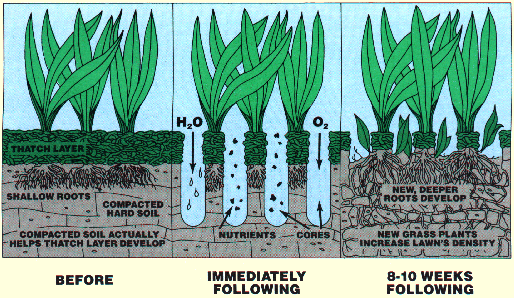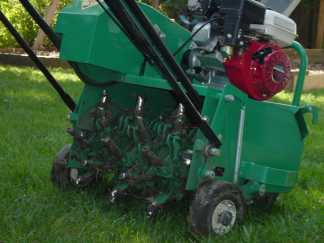 We only offer this service in conjunction with our design-installation services
We only offer this service in conjunction with our design-installation services
Q: What is core aeration?
A: In simplest terms, it is the process of making finger sized holes in your lawn and depositing the removed material on the surface to break down. This allows fertilizer, water and oxygen to get to the roots where healthy grass originates.
Q: Is core aerating effective in improving all species of turf grass?
A: Yes, both cool season (i.e. Kentucky bluegrass) and warm season grasses (i.e. bermuda grass) can be greatly improved.
Q: How do I know if a yard needs aeration?
A: Known clay soils, heavy traffic, more than 1/2″ of thatch, standing water after irrigation or rain, or lawns that brown easily in heat are all excellent candidates. In reality, any yard, healthy or not, can benefit from annual aeration.
Q: Will spiking do the same thing?
A: No. While spiking will put holes in the turf, it actually compacts the soil rather than removing the core. While there are often short-term benefits, in the long term this is counterproductive.
Q: When should aeration be scheduled?
A: For cool season grasses such as bluegrass, bentgrass, rye grass and fine leaf and tall fescue, spring (March-May) and fall (August-November) are best. For warm season grasses such as bermuda, buffalo, St. Augustine, late spring and summer after spring green up (May-July) is preferred.
Q: How often should a lawn be aerated?
A: In areas where the soil has a high clay content, compaction and thatch buildup is more prevalent and aeration should be done twice a year. In areas of more sandy or loamy soils, annual aeration will result in continued healthy lawns and improved irrigation and fertilizing efficiency.
Q: When will positive results be seen in the lawn?
A: Depending on the turf conditions, visual results may or may not be immediate from a single aeration. Subterranean root growth and overall health and stress tolerance will however begin to improve almost at once. Even in the toughest conditions aeration in combination with an appropriate fertilizing, irrigation and weed control program will show dramatic visual results in the second year after a second or third aeration.
Q: Will aeration make the grass grow faster?
A: Yes. Healthy grass will grow faster and thicker. If you are unwilling to mow lush green grass, aeration, fertilizing and watering are counterproductive.
Q: Is aeration a one-time fix that can be discontinued when the lawn has improved?
A: No. Aeration needs to be an ongoing part of a lawn care plan just like fertilizing, weed and pest control, irrigation and mowing. In some cases aeration can be reduced from twice a year to once a year after a couple of seasons.
Q: How deep and how many cores are required for effective aeration?
A: Generally, cores every 4″– 6″ and from 2″– 3″ deep will give best results. It is commonly accepted that the deeper and the closer together the better. The cores left in your yard will usually be about 5/8″ diameter.
Q: How long will it take for the cores left in the lawn to disappear?
A: Depending on weather, soil conditions, watering and mowing frequency, the cores will break down and disappear in about two weeks. This process will add nutrients to the lawn. Raking up the cores reduces aeration effectiveness.

Q: Is aeration for the do-it yourselfer?
A: Yes, aeration can be done by any homeowner that has a do-it-yourself attitude. Most rental stores rent gas powered walk behind aerators. Many homeowners prefer to have a lawn care professional handle this chore.
Q: How much does aeration cost?
A: Cost varies depending on location. Generally rental cost ranges from $30 to $60 per four-hour rental. It will usually take 1 hour to do a 15,000 sq. ft. residential lawn. A lawn care contractor is likely to charge between $75 and $180 for the same lawn. Rates vary.
Q: Is it important to aerate close to obstacles such as drive ways, sidewalks and plantings?
A: Yes. Often these are the places where compaction is most prevalent, where weeds often invade and where irrigation systems often are less effective.
Q: How wet should the yard be for best aeration results?
A: Dry ground reduces the depth of cores and aeration effectiveness. Wet, muddy soil allows deep aeration but at the expense of crusting the soil in the hole, reducing access to the roots and making cores left in the yard a muddy mess that does not break down as fast. Normally, aerating 24 hours after a 1/2″ rain or normal watering is best.
Q: Should aeration be done during times of drought or high heat?
A: No. During this time, the grass growth is less active and aeration could increase the invasion of weeds and possibly increase the rate of water evaporation.
Q: Should newly seeded grass or sod be aerated?
A: No. Sod should not be aerated for at least 12 months. Newly seeded lawns usually can be aerated in the second full season of growth. Multiple pass aeration prior to seeding or sodding is a good way to prepare the soil.
Q: Can aerator tines damage sprinkler heads or other items in the lawn?
A: Yes. You must flag all items in the yard to avoid damage caused by the tines.
Q: When should the lawn be fertilized?
A: Fertilizing immediately after aeration will achieve the best return on your fertilizer investment, as it will more easily get to the root structure at this time.
Q: Will the lawn require more fertilization after aeration?
A: No. The same amount of fertilizer will give quicker and more long lasting results as it will get to the roots where real health occurs.
Q: When should preemergent for weeds be applied?
A: Preemergent is best applied after aeration to reduce the chance of weed invasion in the yard while grass is spreading to the cored holes. Do not apply preemergent if you intend to overseed.
Q: Is reseeding after aeration a good practice?
A: Yes. If the lawn has areas where the stand of grass is thin, broadcast seeding 1–2 weeks after aeration will improve germination, as the seeds will intermix with the deterioration of plugs and have direct access to non-compacted soil in the holes in the turf. In this area, multiple passes with the aeration equipment will dramatically improve soil conditions leading to better overseeding results.
Q: Is dethatching (power raking) necessary in addition to aeration?
A: Only in a case of extreme thatch is this necessary. Power raking only removes thatch but does not improve compaction. Aeration does both in one operation.
Q: Should the lawn be watered after aeration?
A: Yes. Water helps breakdown the cores left in the yard and is particularly effective on the newly exposed root system.
If you have any questions, please contact us.












